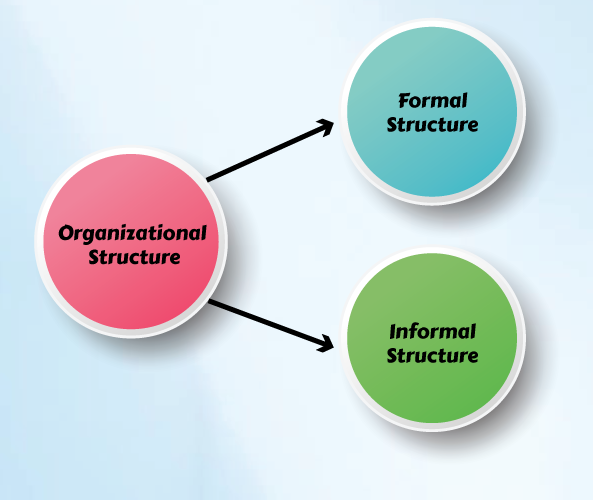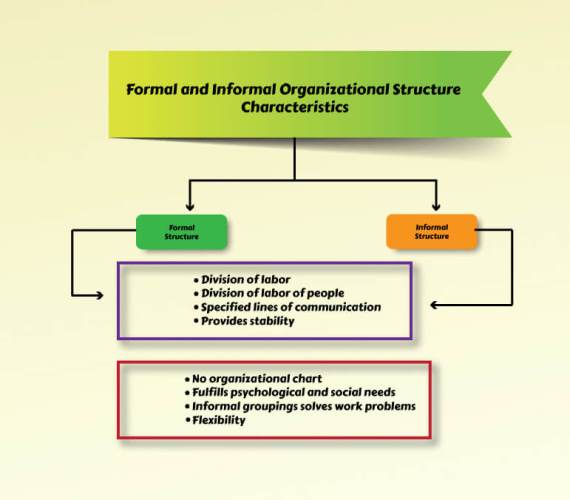Formal and Informal Organizational Structure
For the past four decades, organizational scholars have been repetitively called for to integrate two contrasting, but compatible, concepts of intra-organizational structure. Basically, organizational structure is categorized into Formal and Informal structure. Formal organizational structure is generally based on formally defined roles and responsibilities. Further, informal organizational structure often termed as “social” or “network” structure and is based on interactions of repeated pattern (Hunter, 2015; McEvily et al., 2014).

Figure 1:
In an organizational setting, the formal structures generally contain communication and a chain of authority. If the scope of the problem and its intensity is greater, the problem is more likely to be found in the informal components as quoted by Pretorius (2004). In addition, it is also noted that when the intervention depth is greater in the informal organization, the failure risk and the cost of change is also higher. The existence of structure is when two or more people join together for a common purpose and there is formal & legal relationship between them, this refers to the term formal organization (Sarlak & Salamzadeh, 2014).

Further, there exists a hierarchical order that establishes a logical authority relationship and follows a command chain. Only predetermined channels of contact exist for communication between two participants. There are different types of formal structure such as
- Line Organization
- Functional Organization
- Line and Staff Organization
- Matrix Organization
- Project Management Organization
On the other hand, for a long time, market strategists have recognized that the “informal organization” has a significant impact on the performance or loss of a company. An organization’s success can be greatly influenced by its informal arrangement which be used strategically. Managers may affect the growth of the informal system, despite the fact that it is partly intangible (Sarlak & Salamzadeh, 2014). There are no fixed means of contact in an informal organization, since members can easily communicate with one another and they collaborate in their personal capacities rather than on a technical level.
Formal Organizational structure Characteristics
- The formal organization’s basic is the labor division and specialization.
- The formal organization’s authority and people’s responsibility is defined precisely.
- The communication lines are very clearly specified.
- Provides stability.
Informal Organizational structure Characteristics
- Group assistance and informal groupings are done to solve work problems.
- It accomplishes the members’ psychological and social needs.
- Group assistance and informal groupings are done to solve work problems.
- Overcome gaps in the shortcomings of the management.

Figure 2:
A formal organization and an informal organization are diametrically opposed. The primary difference between these two structures is that in formal structure, formal organization members obey to the command chain, whereas informal organization members will not obey to the command chain. Furthermore, superior-subordinate relationship exists among formal organization members and no such relationship exists among informal organization member.
References
- Hunter, S. D. (2015). Combining theoretical perspectives on the organizational structure-performance relationship. Journal of Organization Design, 4(2), 24–37. https://papers.ssrn.com/sol3/papers.cfm?abstract_id=3420937
- McEvily, B., Soda, G., & Tortoriello, M. (2014). More formally: Rediscovering the missing link between formal organization and informal social structure. Academy of Management Annals, 8(1), 299–345. https://journals.aom.org/doi/abs/10.5465/19416520.2014.885252
- Pretorius, S. J. J. (2004). Effective supply chain management in the furniture retail industry. University of Pretoria. https://repository.up.ac.za/handle/2263/28934 Sarlak, M. A., & Salamzadeh, Y. (2014). Analyzing the impacts of informal organizations on formal routines in a networked organization. Journal of Asian Scientific Research, 4(12), 768. http://www.conscientiabeam.com/pdf-files/oth/2/jasr-2014-4(12)-768-783.pdf

 Previous Post
Previous Post Next Post
Next Post